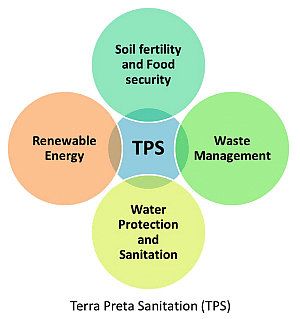History and Technology of Terra Preta Sanitation
Abstract
:1. Introduction
2. History of Terra Preta
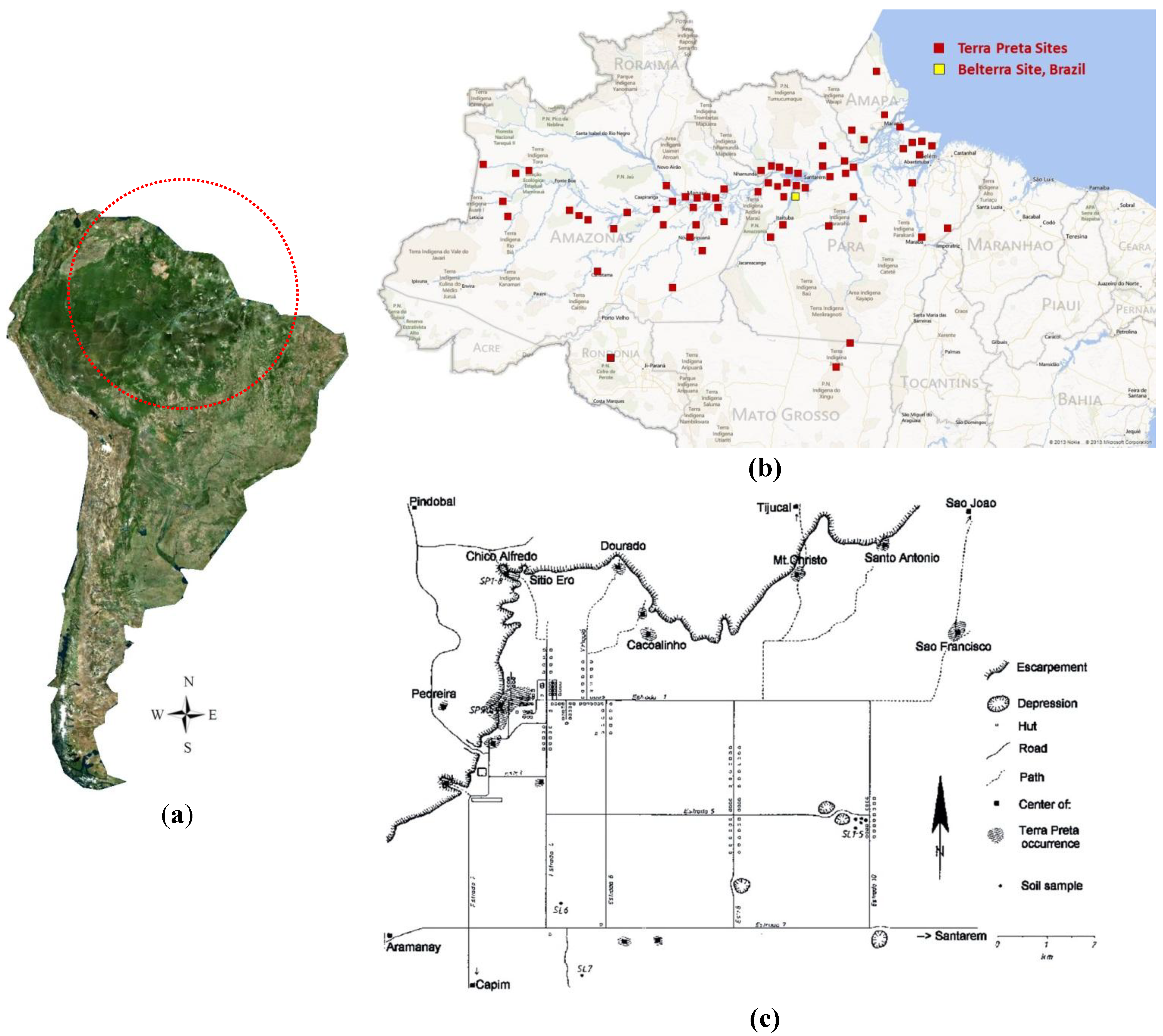


3. Terra Preta Sanitation Systems
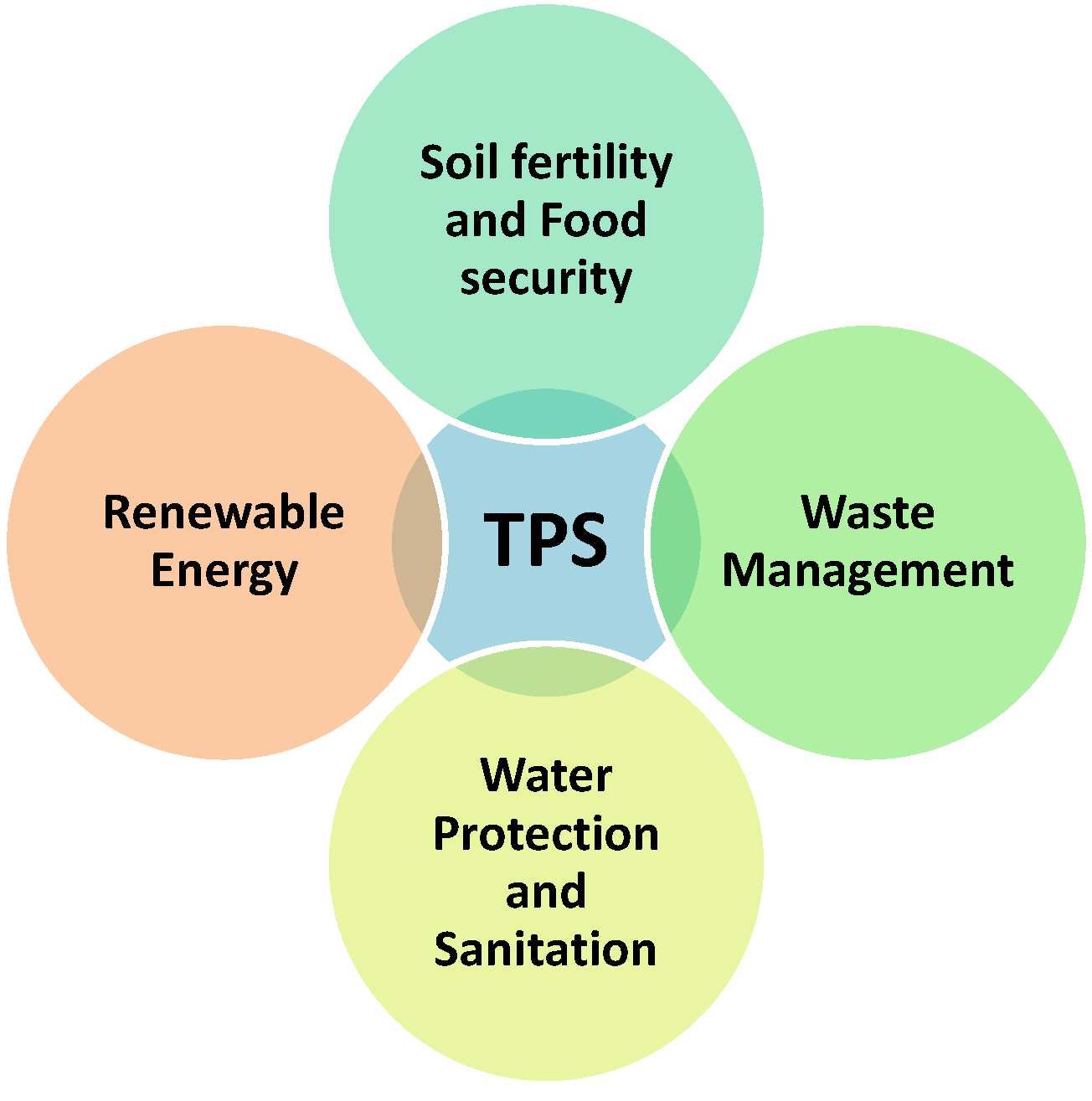
- ▪
- Dry TPS systems;
- ▪
- Systems with flush water.
3.1. Dry TPS Systems (without Flush Water)
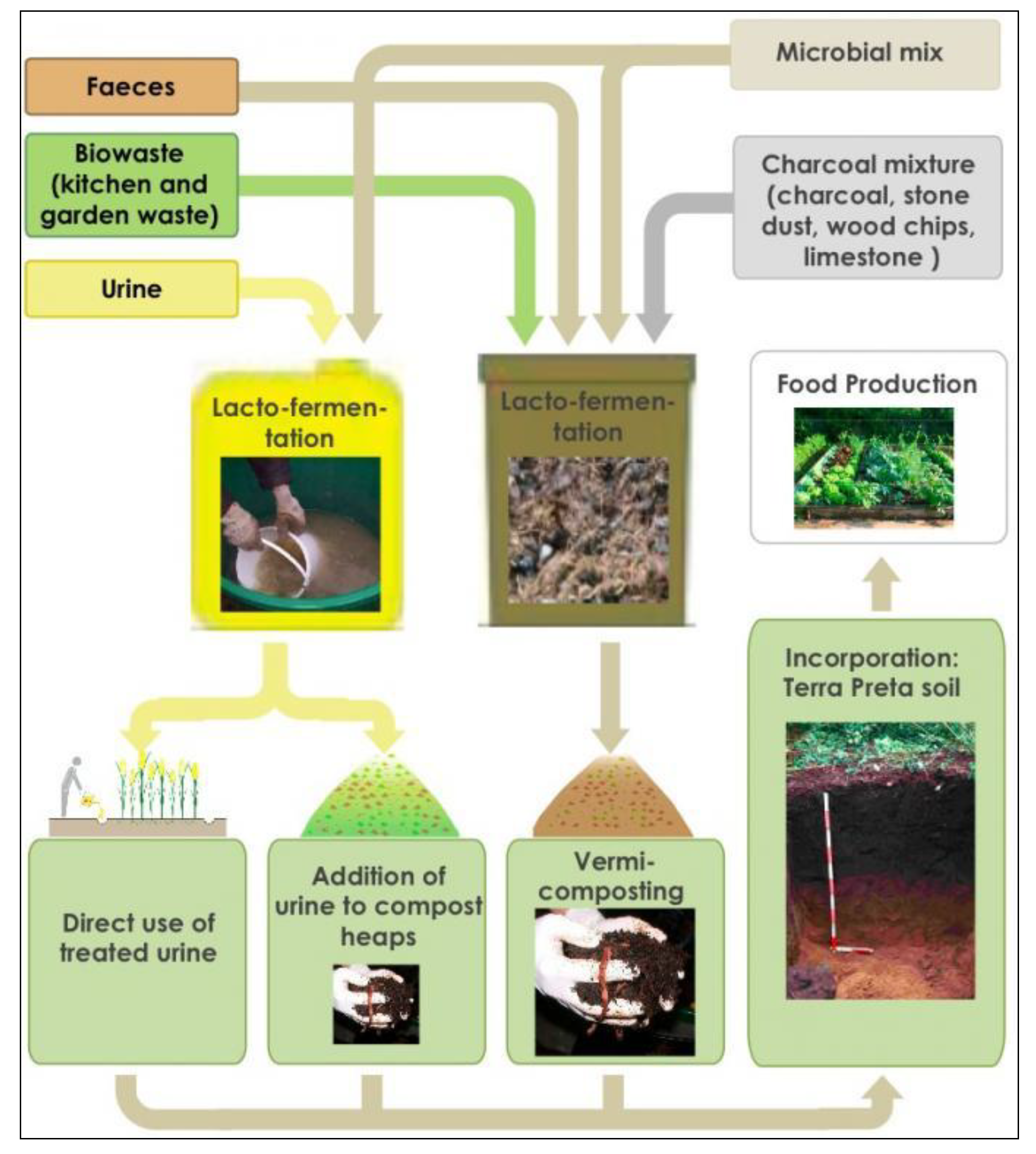
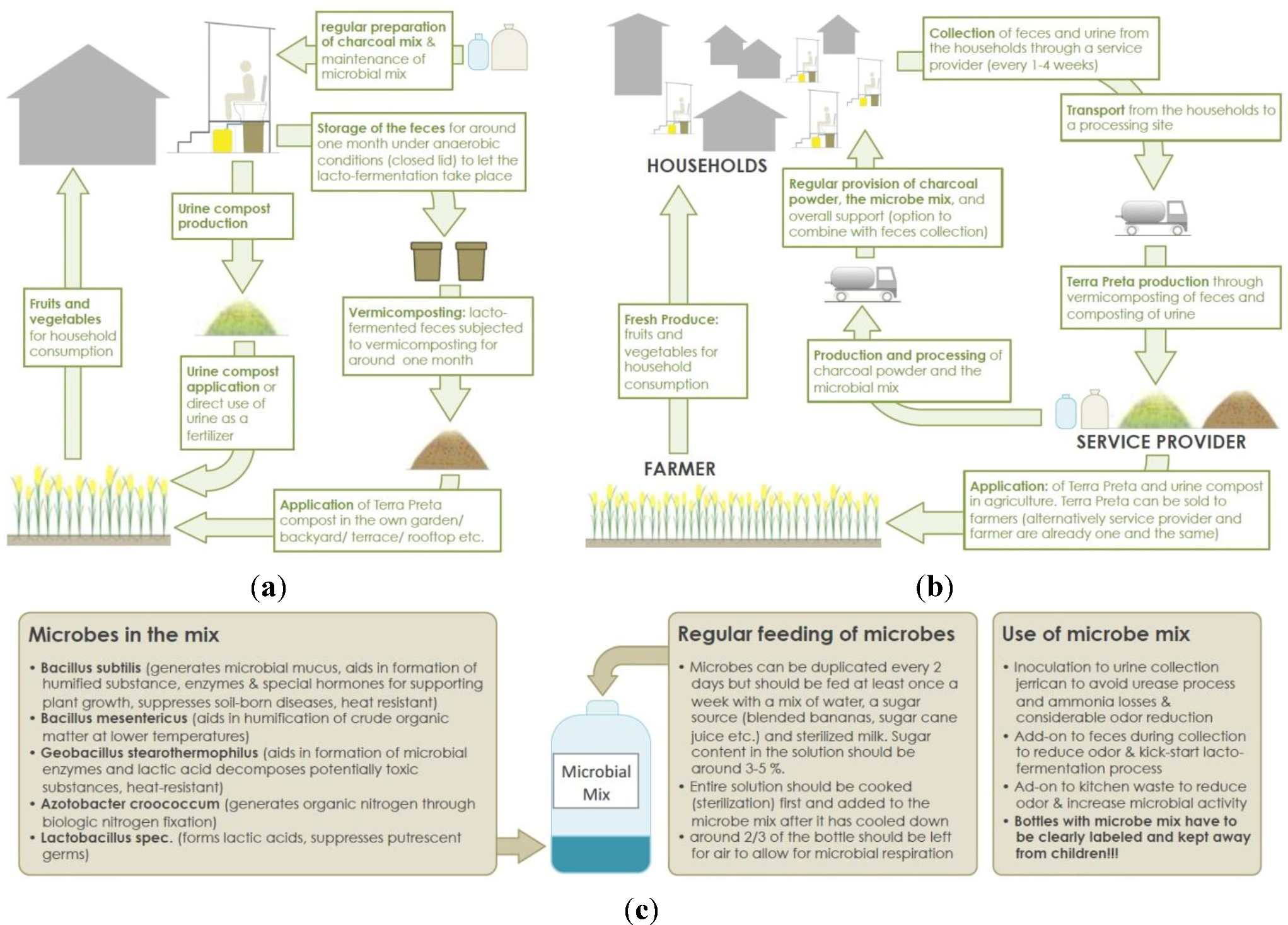
3.2. TPS Systems with Flush Water
- ▪
- Integrated TPS systems;
- ▪
- TP made of settled sludge of septic tanks or pour flush toilets;
- ▪
- TP made of sewage sludge after collection and treatment in a WWTP.
3.2.1. Integrated TPS System
3.2.2. TP Made of Settled Sludge from Septic Tanks or Pour Flush Toilets
3.2.3. TP Made of Sewage Sludge
4. Case Studies

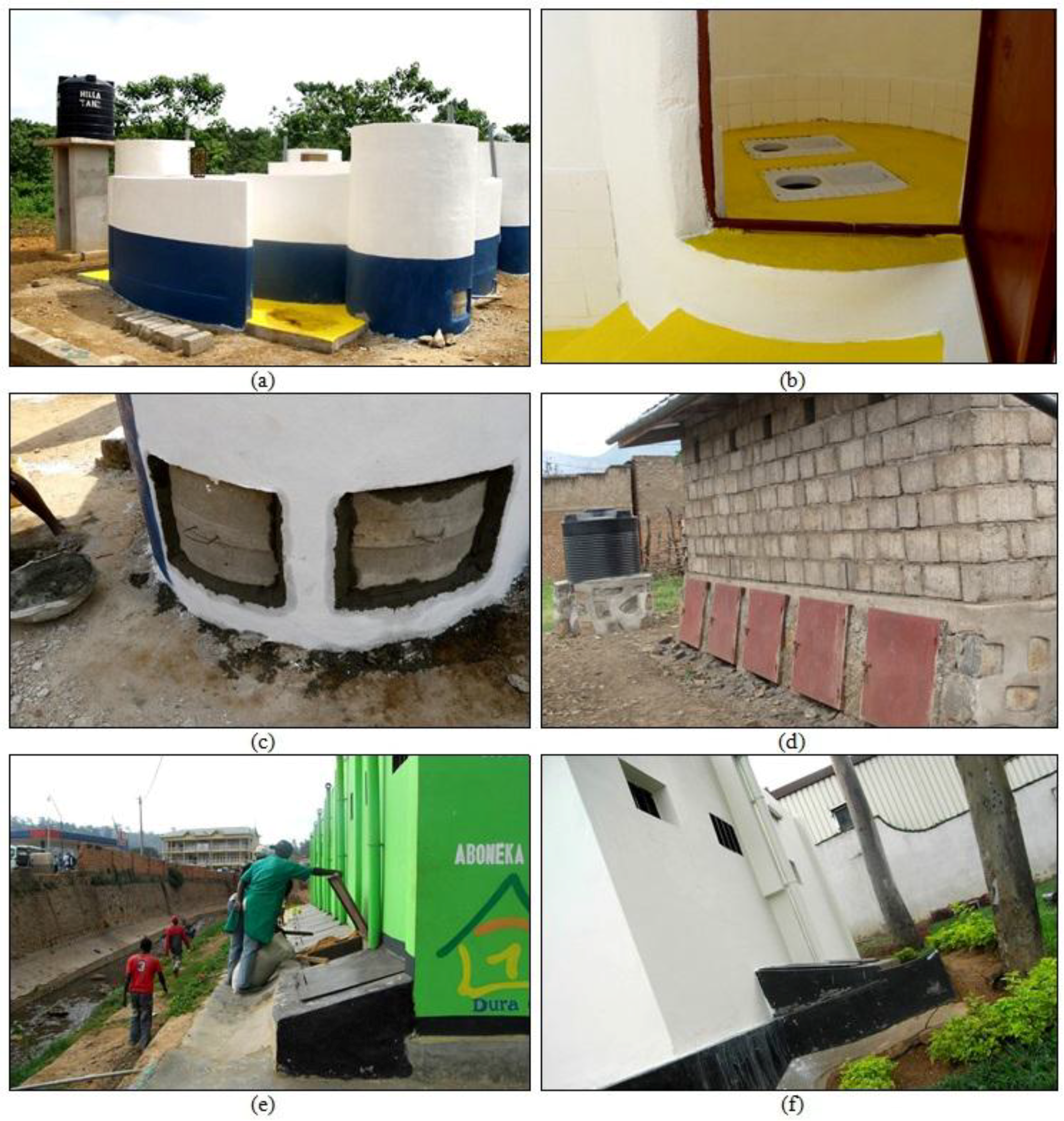
5. Conclusions
- ▪
- An analysis of a former civilization in the Amazon (nowadays Brazil) highlights the possibility to close the loop with a more sustainable lifestyle integrating soil fertility, food security, waste management, water protection and sanitation, renewable energy;
- ▪
- TPS System is the name of the concept, which aims to use this technology for a safe and recycling-oriented treatment of wastes;
- ▪
- TPS System can be implemented in different steps of the sanitation chain. Major driver for TPS is the efficient use of organic matter as well as macro and micro nutrients;
- ▪
- In light of decreasing soil fertility and humus quality worldwide and desertification, TPS can play an important role to solve the sanitation problem and sustainable soil management, which leads to increased food security.
Acknowledgments
Author Contributions
Conflicts of Interest
References
- Water Sanitation and Health. Global Water Supply and Sanitation Assessment 2000 Report. Available online: http://www.who.int/water_sanitation_health/monitoring/jmp2000.pdf (accessed on 25 October 2013).
- Post Sanitation Proposal for Overall Vision, Summary Targets, Detailed Targets, Indicators and Definitions. Available online: http://www.wssinfo.org/fileadmin/user_upload/resources/Post-2015-proposal-for-Sanitation-Targets-and-Indicators_-December-2012_proposed-revisions_final.pdf (accessed on 25 October 2013).
- Werner, A.; Panesar, A.; Rüd, S.B.; Olt, C.U. Ecological sanitation: Principles, technologies and project examples for sustainable wastewater and excreta management. Desalination 2009, 248, 392–401. [Google Scholar] [CrossRef]
- De Feo, G.; Laureano, P.; Drusiani, R.; Angelakis, A.N. Water and Wastewater Management Technologies through the Centuries. Water Sci. Technol. 2010, 10, 337–349. [Google Scholar]
- Bond, T.; Roma, E.; Foxon, K.M.; Templeton, M.R.; Buckley, C.A. Ancient water and sanitation systems—applicability for the contemporary urban developing world. Water Sci. Technol. 2013, 67, 935–941. [Google Scholar] [CrossRef]
- Factura, H.; Bettendorf, T.; Buzie, C.; Pieplow, H.; Reckin, J.; Otterpohl, R. Terra Preta sanitation: Re-discovered from an ancient Amazonian civilization—Integrating sanitation, bio-waste management and agriculture. Water Sci. Technol. 2010, 61, 2673–2679. [Google Scholar] [CrossRef]
- Glaser, B. Prehistorically modified soils of central Amazonia: A model for sustainable agriculture in the twenty-first century. Philos. Trans. R. Soc. Biol. Sci. 2007, 362, 187–196. [Google Scholar] [CrossRef]
- Terra Preta. Available online: http://www.gerhardbechtold.com/TP/gbtp.php (accessed on 20 December 2013).
- Brewer, C.E.; Brown, R.C. Biochar. In Comprehensive Renewable Energy, 1st ed.; Sayigh, A., Ed.; Elsevier: Philadelphia, PA, USA, 2012; Volume 5, pp. 357–384. [Google Scholar]
- Tollefson, J. Amazon ecology: Footprint in the forest—Researchers are tracking just how much impact ancient peoples had on the Amazon. Nature 2013, 502, 160–162. [Google Scholar] [CrossRef]
- International Biochar Initiative. Available online: http://www.biochar-international.org/biochar/soils (accessed on 20 December 2013).
- Steiner, C.; Teixeira, W.; Lehmann, J. Long term effect of manure, charcoal and mineral fertilization on crop production and fertility on a highly weathered Central Amazonian upland soil. Plant Soil 2007, 291, 275–290. [Google Scholar] [CrossRef]
- Umlingo Solutions. Available online: http://umlingosol.co.za/biochar.html (accessed on 20 December 2013).
- Herzen, B.; Talsma, L. Conversion of Human Waste into Biochar Using Pyrolysis at a Community-Scale Facility in Kenya—Various Documents on Results from Research Grant; Stanford University and The Climate Foundation: Stanford, CA, USA.
- Wendland, C.; Deegener, S.; Jorritsma, F. Experiences with urine diverting dry toilets (UDDTs) for households, schools and kindergarten in Eastern Europe, the Caucasus and Central Asia (EECCA). Sustain. Sanit. Pract. 2011, 6, 16–22. [Google Scholar]
- Shalabi, M. Vermicomposting of Faecal Matter as a Component of Source Control Sanitation. Ph.D. Thesis, Technical University of Hamburg, Hamburg, Germany, 2006. [Google Scholar]
- Taricska, J.R.; Long, D.A.; Chen, J.P.; Hung, Y.T.; Zou, S.W. Anaerobic digestion. In Biosolids Treatment Processes; Wang, L.K., Shammas, N.K., Hung, Y.T., Eds.; Humana Press Inc.: New York, NY, USA, 2007; Volume 6, pp. 177–205. [Google Scholar]
- Madigan, M.; Martinko, J. Brock Biology of Microorganisms, 11th ed.; Pearson Prentice Hall: Upper Saddle River, NJ, USA, 2006. [Google Scholar]
- SSWM (Sustainable Sanitation and Water Management). Available online: http://www.sswm.info/category/implementation-tools/water-use/hardware/toilet-systems/terra-preta-toilet (accessed on 29 January 2014).
- Kim, J.S.; Sparovek, G.; Longo, R.M.; de Melo, W.J.; Crowley, D. Bacterial diversity of terra preta and pristine forest soil from the Western Amazon. Soil Biol. Biochem. 2007, 39, 684–690. [Google Scholar] [CrossRef]
- Brown, V.; Jakson, D.W.; Khalifé, M. Melbourne metropolitan sewerage strategy: A portfolio of decentralised and on-site concept designs. Water Sci. Technol. 2009, 62, 510–517. [Google Scholar] [CrossRef]
- Itchon, G.; Miso, A.; Gensch, R. The effectivity of the Terra Preta Sanitation (TPS) process in the elimination of parasite eggs in fecal matter: A field trial of Terra Preta Sanitation in Mindanao, Philippines. In Proceedings of the 1st International Conference on Terra Preta Sanitation, Hamburg, Germany, 28–31 August 2013.
- Schuetze, T.; Lee, J.W.; Lee, T.G. Sustainable Urban (re-)Development with Building Integrated Energy, Water and Waste Systems. Sustainability 2013, 5, 1114–1127. [Google Scholar] [CrossRef]
- Andreev, N.; Boincean, B.; Ronteltap, M.; Lens, P.N.L. The effect of terra preta like substrate on germination and shoot growth of radish and parsley. In Proceedings of the 1st International Conference on Terra Preta Sanitation, Hamburg, Germany, 28–31 August 2013.
- FU Berlin Terra Boga Projekt. Available online: http://www.terraboga.de (accessed on 25 October 2013).
- Libralato, G.; Ghirardini, A.V.; Avezzù, F. To centralise or to decentralise: An overview of the most recent trends in wastewater treatment management. J. Environ. Manage. 2012, 248, 61–68. [Google Scholar] [CrossRef]
- Böttger, S.; Töws, I.; Bleicher, J. Terra Preta—Production from sewage sludges of decentralised wastewater systems. In Proceedings of the 1st International Conference on Terra Preta Sanitation, Hamburg, Germany, 28–31 August 2013.
- Scheinemann, H.; Dittmar, K.; Erfurt, K.; Stoeckel, F.S.; Krueger, M.E. Hygienisation and nutrient conservation of sewage sludge or cattle manure by fermentation. In Proceedings of the 1st International Conference on Terra Preta Sanitation, Hamburg, Germany, 28–31 August 2013.
- Prabhu, M.; Horvat, M.; Lorenz, L.; Otterpohl, R.; Bettendorf, T.; Mutnuri, S. Terra Preta as an alternative for the management of sludge from wastewater treatment plant. Proceedings of the 1st International Conference on Terra Preta Sanitation, Hamburg, Germany, 28–31 August 2013.
- Morgan, P. Ecological Toilets—Start Simple and Upgrade from Arborloo to VIP; Stockholm Environment Institute, EcoSanRes Programme: Stockholm, Sweden, 2009. Available online: http://www.ecosanres.org/pdf_files/EcologicalToilets-PeterMorgan-Mar2009.pdf (accessed on 21 January 2013).
- Gensch, R. Terra Preta Sanitation; Sustainable Sanitation Center: Cagayan de Oro, Philippines, 2010. Available online: http://www.sswm.info/sites/default/files/reference_attachments/GENSCH%202010%20b%20Terra%20Preta%20Sanitation.pdf (accessed on 21 January 2013).
© 2014 by the authors; licensee MDPI, Basel, Switzerland. This article is an open access article distributed under the terms and conditions of the Creative Commons Attribution license (http://creativecommons.org/licenses/by/3.0/).
Share and Cite
De Gisi, S.; Petta, L.; Wendland, C. History and Technology of Terra Preta Sanitation. Sustainability 2014, 6, 1328-1345. https://doi.org/10.3390/su6031328
De Gisi S, Petta L, Wendland C. History and Technology of Terra Preta Sanitation. Sustainability. 2014; 6(3):1328-1345. https://doi.org/10.3390/su6031328
Chicago/Turabian StyleDe Gisi, Sabino, Luigi Petta, and Claudia Wendland. 2014. "History and Technology of Terra Preta Sanitation" Sustainability 6, no. 3: 1328-1345. https://doi.org/10.3390/su6031328



